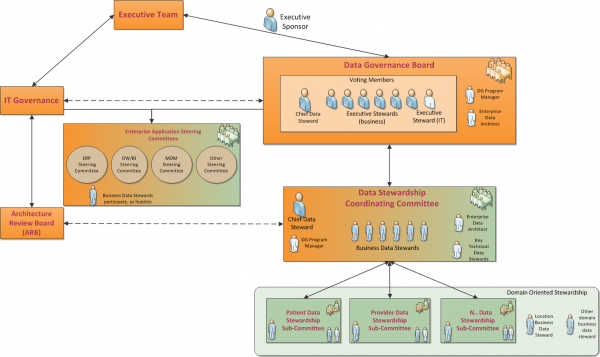In my last blog posting, I talked about the need for Data Governance and Data Stewardship to work collaboratively across business units and that organizations should be formed over time to help enable this collaboration.
While no two Data Governance programs are identical, below is an example structure which might be adopted, in a phased approach, as applicable for your organization’s culture, size, data complexity, and other factors. The objects in orange represent strategic oriented organizations while objects in green represent more of a tactical focus. In this series of articles the emphasis will be on the Data Governance and Data Stewardship organizations; other organizations (executive team, IT governance, ARB) are shown only to provide context and identify key relationships. This article focuses on the Data Governance Board.
|
Figure 1 – Example Data Governance and Data Stewardship Organizational Chart |
The Data Governance Board is the key decision making body in Enterprise Data Governance. It is formed in order to make the key strategic decisions regarding the enterprise data asset and about Enterprise Information Management (EIM) efforts. Other types of assets have enterprise level boards (e.g., finance board, HR board), and so it is fitting that there be a board dedicated to the data asset. If we’re really serious about data being a vital strategic asset in the 21st century it should not be that difficult to stand up a Data Governance Board (identifying and working with an executive sponsor is critical and identifying significant risks such as lack of regulatory compliance can provide needed ammunition). It is crucial that the emphasis be upon data and information – not IT, not infrastructure, not applications (except enterprise data applications – EDW, MDM, Enterprise Metadata Repository, etc.) – as typically there is already governance in place for these. Folding Data Governance into these existing governance structures leads to a dilution of the importance of data, and then we’re back into the same old way of working…
As you can see above, there is a flow of communication between the Executive Team and the Data Governance Board. This is typically enabled by the Executive Sponsor. I participated on one Data Governance board where the CEO, CFO, and Chief Actuary were all participants due to the severe data problems being faced. While this level of participation is ideal, it is atypical.
The Data Governance Board interacts with IT Governance, typically through the CIO or an IT director. If the CIO will participate in the Data Governance Board, it is very important that he or she does not attempt to dominate the board or hijack the board for other purposes – Data Governance must be business and data-centric to succeed. At a federal agency, when developing their Data Governance strategy, it was determined that each office would have the same voting power with each office represented by an Executive Steward with IT having just one Executive Steward on the board. At this agency, there was concern that the larger offices would be the “800 pound gorillas” on the board. Conversely, the large offices were concerned that they wouldn’t have proportional representation. It was determined to follow a model somewhat similar to the U.S. Senate where every state has the same number of votes as any other state regardless of size, e.g., California and South Dakota both have the same number of votes in the US Senate. It would be at the Data Stewardship level where the numbers of Business Data Stewards, Technical Data Stewards, Subject Matter Experts (SME), and Data Owners would be more representative of the business units (though these parties still must have an enterprise focus!).
The Data Governance Board is facilitated by the Chief Data Steward. The Chief Data Steward should come from the business, have a solid understanding of the importance of data, metadata, and data quality, and have significant enterprise level exposure and respectability. The Chief Data Steward works very closely with the Executive Sponsor. At a large, innovative healthcare provider the role of Chief Data Steward is a full time position.
Data Governance and Data Stewardship must be considered to be a program – not a project! There will always be data challenges and as the only constant is change the need for Data Governance and Data Stewardship will continue and grow. The Data Governance Program Manager, typically from IT, supports the Chief Data Steward in administrative and coordination activities and ensuring that decisions are communicated, acted upon, and measured. Projects initiated by the Data Governance Board or Data Stewardship Coordinating Committee, as appropriate, are managed or overseen by the Data Governance Program Manager.
While the Data Governance Board is critical, the majority of the work involved in Data Governance and Data Stewardship takes place at a lower level. In my next article, I will continue the discussion by describing the Data Stewardship Coordinating Committee.

